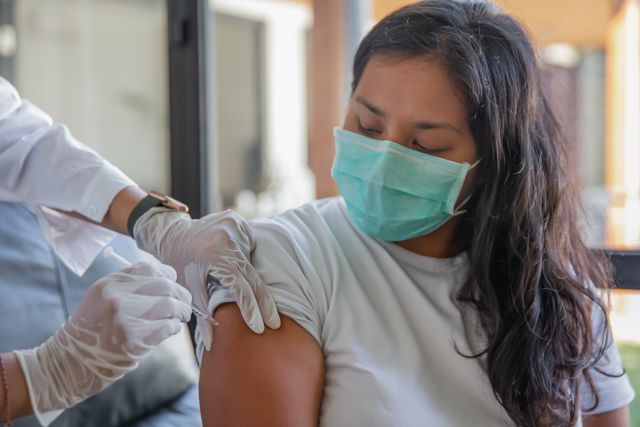Updated on January 10, 2022.
The U.S. Centers for Disease Control and Prevention (CDC) endorsed the unanimous vote of its vaccine advisory panel to recommend that the two-dose Pfizer or Moderna COVID vaccines be preferred over Johnson & Johnson’s vaccine for all people ages 18 and older.
The Advisory Committee on Immunization Practices (ACIP) met on December 16 to review more safety data on the single-dose vaccine, following continued reports of thrombosis and thrombocytopenia syndrome (TTS)—a rare but serious clotting condition associated with the J&J shot.
Just two days before the ACIP’s vote, the U.S. Food and Drug Administration (FDA) also weighed in on the vaccine, advising that anyone with a history of TTS should not get the J&J COVID vaccine. Adults who developed this condition after getting the shot should choose to receive either the Pfizer or the Moderna COVID vaccine as their booster.
The FDA noted however that the benefits of the J&J COVID shot still outweigh possible risks among adults and that people should talk to their healthcare provider (HCP) about which COVID vaccine is best for them based on their individual circumstances and risk factors.
What is TTS and what causes it?
Thrombosis and thrombocytopenia syndrome (TTS) is a rare blood clotting condition that has been linked to J&J's vaccine—not the Pfizer or the Moderna COVID vaccines.
TTS is characterized by a very rare blood clot in the brain (CVST) or clots in other parts of the body in combination with low levels of blood platelets. CVST can cause blood cells to break and leak into the brain. It can be life-threatening but is usually manageable if detected and treated early.
The J&J shot is a viral vector vaccine that relies on a different technology than the Pfizer and Moderna mRNA vaccines. It uses a modified version of another type of virus as a vector (or mode of delivery) for genetic material that codes for a piece of the coronavirus in order to trigger a protective immune response.
The viral vector used by the J&J vaccine is a common-cold virus called adenovirus 26. Scientists speculate that these vaccines could be triggering an immune response against platelet factor 4, a protein involved in blood clotting. This results in platelet destruction and release of clot-promoting material.
What prompted the ACIP’s latest vote?
The single-dose Johnson & Johnson vaccine was authorized in late February 2021 for use in adults ages 18 and older.
By April, early reports of TTS associated with the J&J vaccine raised alarms and triggered a pause in the use of the vaccine. Later that month, the ACIP met to review more evidence about the rare blood clots reported in a handful of people.
At the time, six women between the ages of 18 and 48 had developed cerebral venous sinus thrombosis (CVST), a very rare blood clot in the brain—and possibly in other parts of the body— in combination with low levels of blood platelets (thrombocytopenia). These complications developed 6 to 13 days after they received the J&J shot.
The pause was intended to give healthcare providers across the country time to plan for the diagnosis and management of this rare cluster of symptoms. Usually, an anticoagulant drug called heparin is used to treat blood clots. But TTS resulting from the J&J vaccine should be managed different, since the use of heparin may be dangerous.
Ultimately, the panel decided that the rollout of the J&J shot should restart. The group concluded that the vaccine should come with a new warning, but its benefits still outweigh any risks.
Since then, the J&J booster has also been authorized. Adults who’ve received the J&J shot should get a Pfizer or Moderna booster two months later, or a J&J under some circumstances-- including if they have an allergy or had a severe reaction to an mRNA vaccine. Adults who received two doses of the Moderna or Pfizer vaccine should receive a booster of either of those mRNA vaccines five months later.
Children ages 12 to 17 should also get a Pfizer booster shot five months after their second shot.
As of January 6, about 17 million U.S. adults have received the J&J vaccine and more than 1 million adults have received the J&J booster.
But the CDC has continued to monitor reports of TTS and additional cases were confirmed. A preliminary November report that has yet to be published indicated that there have been 52 TTS cases among more than 16.4 million Americans who received the J&J vaccine.
An August FDA report also found that there are five to six cases of TTS per one million J&J vaccinations worldwide. Most of these cases (69 percent) occurred in the United States among adults younger than 65-years old. Of the cases where gender was reported, 55 percent involved women. TTS occurred most often (about one case per 100,000 J&J doses) among women between 39 and 49-years old. About one in seven cases has been fatal.
COVID is still riskier
Although the risk for TTS is enough to warrant caution among younger women, experts point out that the risk of blood clots is still much higher among those infected with COVID than for those who receive the J&J vaccine.
COVID-19 can result in inflammation that triggers an overwhelming release of proteins called cytokines. Normally, cytokines help coordinate the body’s response to infection. But in some cases, this response can rage out of control, doing more harm than good. This so-called cytokine storm can damage the blood vessels and organs and lead to blood clots.
What you can do to protect yourself
COVID-19 vaccines have undergone and will continue to undergo intensive monitoring. Health officials are constantly monitoring the vaccines being used in the United States for both safety and efficacy.
In fact, the halted rollout of the J&J vaccine and the investigations that followed are a reassuring sign that vaccine safety reporting systems are working.
Knowing your risk factors for TTS and warning signs of the condition can also help keep you safe.
TTS may be missed or diagnosed late because its symptoms overlap with other conditions. Responding quickly to the following warning signs improves the likelihood of recovery:
- Headache
- Blurred vision
- Fainting or loss of consciousness
- Loss of control over movement in part of the body
- Seizures
- Severe abdominal or leg pain
- Shortness of breath
Additional warning signs of low platelet count include:
- New easy or unexplained bruising
- Tiny red spots on the skin (petechiae)
Among women, those younger than 50-years old are at higher risk for TTS, following vaccination with the J&J shot. Women between 30 and 39, in particular, are more likely to be affected.
Other possible risk factors for the condition include obesity, use of oral contraceptives, hypothyroidism, and high blood pressure.
Treatment for TTS, which should begin right away, may include fluids, antibiotics if infection is present and medicine to control seizures or stop the blood from clotting.
TTS is typically reported within two weeks of vaccination. Risk for the condition decreases over time. So, those who received the vaccine more than three weeks ago are at much lower risk.






